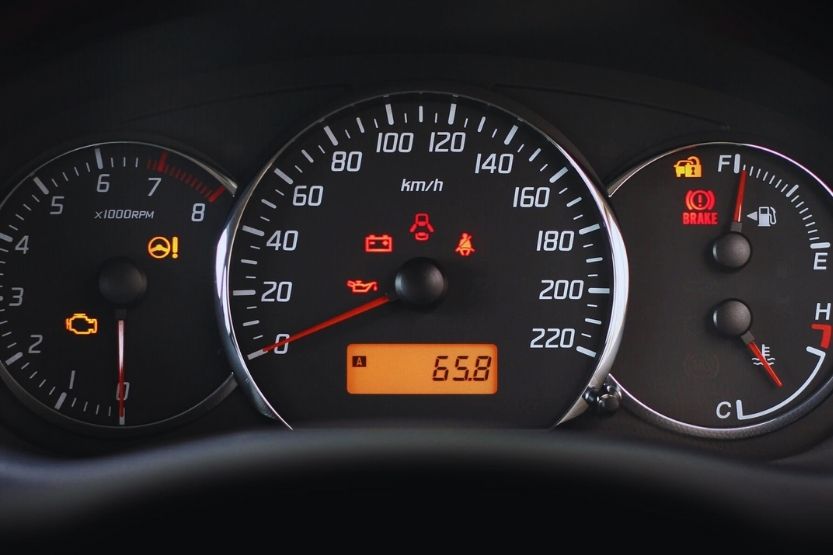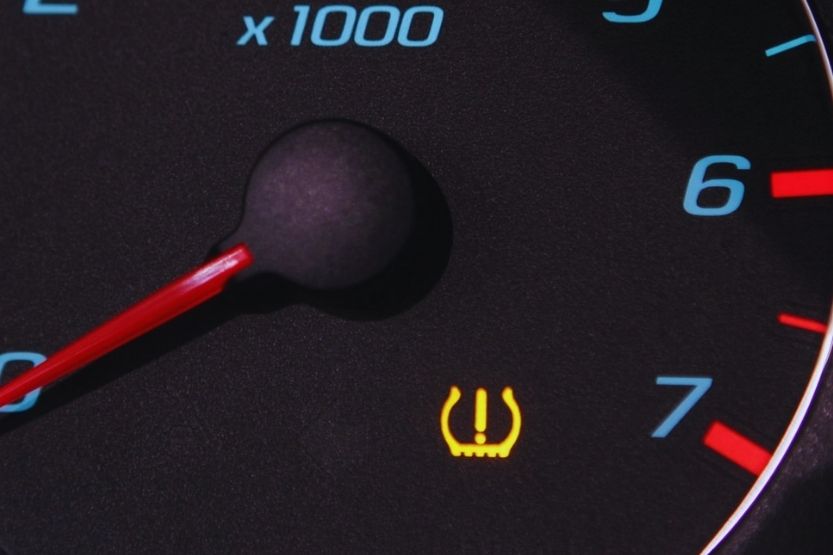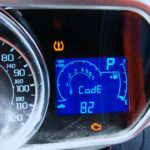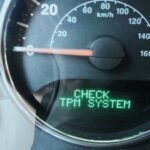Any of the check gauges on a vehicle dashboard can light up at any time when they need attention. What does the “check gauges” light mean, and how do you fix it?
Gauges display information about your car’s various systems, such as its electrical systems and fluids (e.g., brake fluid and engine oil). When gauges light up several times, it usually means one of them isn’t working properly. To know which one is malfunctioning, keep your engine running and check all the gauges on your dashboard.
Read on to learn more about the “check gauges” indicator light means and how to prevent it from coming on.
What Does the Check Gauges Light Mean?

There’s a reason why these gauges are placed on your dashboard or instrument panel, where you can easily see them. They are critical components for ensuring your car is efficient and safe to drive.
Stop Driving and Determine the Problem
If any of these gauges light up, it means that you need to stop driving to determine the problem it’s pointing out and fix it. The problem could be a malfunctioning component of your car, which could be anything, such as:
- Low levels of oil in the engine
- A fuel cap that has become loose
- Engine overheating
- Electrical system problems
- Emission control system failure
Can Mean Different Things for Every Car Brand and Model
But “check gauges” can mean different things for every car brand and model. For people who drive a Ford F-150, a check gauge light could warn you of an issue that’s connected to your gauges for oil, water, and voltage.
In a Jeep, when the check gauge illuminates, it means that there could be a problem with engine temperature or oil levels.
Common Car Gauges
The gauges that you can expect to find on the dashboard of many cars are:
1. Oil Pressure Gauge Light
It’s normal for your oil pressure gauge to go up and down with the engine rpm (revolutions per minute). The faster the motor spins, the higher the oil pressure.
Should Stay within 25 to 65 psi
The oil pressure gauge should stay within 25 to 65 psi while your car engine runs. If it starts going higher or lower, then you’ve got yourself a problem. Oil pressure is an important factor in determining the lifespan of your car’s internal combustion engine.
Oil Pressure Around 80+ psi
This could mean there’s a blockage in the filter or gallery. It may also be the consequence of using the wrong grade of oil. The engine temperature will also cause the oil pressure to increase.
Too Low Oil Pressure
If it’s too low, there won’t be enough lubricant that passes through the system. Depending on the problem’s severity, it could cause friction between different engine parts. This, in turn, leads to a decline in engine performance, which could manifest as poor gas mileage and engine stalling.
2. Temperature Gauge Light
Engine Is Running Too Hot
When the temperature gauge lights up, it could mean your car’s engine is running too hot. This could be due to different reasons, such as:
- Leaking of the cooling system,
- Corroded hoses,
- Blocked hoses from mineral deposits,
- A dead or dying water pump, and
- Faulty radiator.
Get the Car Regularly Inspected
Fortunately, most modern cars have a durable engine. And as long as their cooling system is working properly, there shouldn’t be any issues about overheating. To avoid overheating issues down the road, be sure to get your car regularly inspected.
So, what is the normal range for an engine temperature gauge? And what happens when the temperature of your engine rises beyond the upper limit?
Should Be Between 195°F and 220°F
Ideally, the needle on the check gauge should stay in the middle. But in most cases, experts agree that the temperature gauge should be between 195°F and 220°F.
Once it reaches 230°F and above, the cooling system may fail and potentially cause irreversible damage to the engine, gaskets, hoses, and seals.
3. Battery Low Gauge Light
The battery gauge light, which is in the shape of a battery, typically comes on for a few seconds while you’re driving. It means that your car’s battery isn’t generating enough voltage.
Causes of a Failing Battery
Here are some of the reasons your car battery may fail:
- Extreme weather
- Too old to hold a full charge
- Defective diodes
- Parasitic drain
But it’s not always your battery’s fault your car’s electrical system loses power.
Other Causes
A failing battery might also be due to the following:
- Defective charging system (i.e., the alternator isn’t converting enough electrical energy to recharge the battery),
- Faulty electrical wiring,
- Voltage regulator malfunction, and
- A corroded battery cable.
Switch Off All Parts and Accessories That Uses Electricity
What should you do if your battery gauge light comes on? Switch off all car parts or accessories that use electricity (e.g., air conditioning and stereo), except for the headlights.
This will help conserve the remaining power in the battery. Then, make sure you get it fixed by a professional mechanic as soon as possible.
4. Brake Warning Gauge Light
A brake warning gauge light (or brake warning light) could mean different things since there are several types of brake system warning lights on your dashboard. These include:
- Brake light (what people usually refer to whenever they mention brake warning light)
- Brake pad wear light
- Anti-Lock Brake System (ABS) light
- Parking brake light
Reasons Why the Brake Warning Gauge Light to Come Off
Each light has a specific function. So, the question is, what causes the brake warning gauge light to come off? Here are some of the possible reasons:
- There’s no hydraulic pressure on one side of your brake system.
- The fluid level in your brake master cylinder is dangerously low. This car component converts the pressure that comes from the brake pedal into hydraulic pressure.
- The brake pad has become too thin, which will eventually cause the brake pad wear sensor to touch the rotor.
How to Diagnose
Aside from the gauge’s light, there are other ways to know if there’s something wrong with your brake system. You might hear odd sounds when you’re pressing the brake pedal. If the sound is grinding, it means the brake pads are already worn out.
Do Not Drive Once Brake Warning Light Goes Off
Regardless of the cause, you shouldn’t continue driving once your brake warning light goes off. This is a dangerous situation to be in. Get in touch with a professional mechanic as soon as you can to get your car inspected and repaired.
5. Transmission Gauge Light

Symbol Varies Depending on Model and Year
Not all cars have a transmission gauge light. But for cars equipped with this gauge light, the symbol representing it will usually depend on their model and year of manufacture.
Some cars may display texts in the Driver’s Information Center (DIC), while others display a thermometer or gear with an exclamation mark symbol.
Indicates a Wide Range of Transmission-related Issues
Regardless of what it looks like, one thing’s for sure—you don’t want the transmission gauge light to go off. When it does, it indicates a wide range of transmission-related issues. Some cars only turn it on when there’s excessive heat. Excessive heat causes many common transmission problems.
Low Engine or Transmission Fluid
Another reason you would see it illuminated is if the engine fluid or transmission fluid is low. When there’s insufficient fluid, the moving parts of your transmission will eventually become damaged due to increased friction.
The transmission gauge light often comes off alongside the ‘check engine gauges’ light. To know for certain what the transmission gauge light (or any warning light on your car’s dashboard) means, always refer to your owner’s manual.
Other Signs of a Faulty Transmission
Other signs that you have a faulty or failing transmission:
- You hear unusual sound coming from your transmission. This harsh sound could resemble buzzing, clunking, humming, or whining.
- It refuses to shift from one gear to another.
- Your transmission is slipping. This causes a variety of symptoms, such as delayed or weak acceleration, won’t go into reverse, and engine chugging.
Is It Safe to Continue Driving with the Transmission Gauge Light On?
Since most transmission gauge light triggers could be serious, you should stop driving your car when it comes on. Besides, if your car starts with a faulty transmission, it wouldn’t run fast or go too far. Or worse, it may not start at all.
Fail-safe Mode
Fortunately, when your car has a faulty transmission, it usually goes into a fail-safe mode, allowing you to drive to the nearest automotive shop or home. Please note: When your car is in fail-safe or “limp” mode, limit your speed between 35 and 40 miles per hour (mph).
Again, what does it mean when the Check Gauges light is on? When the Check Gauges light is on, you should check your car’s gauges, including the electrical system, engine oil, among others.
6. Power Steering System Gauge Light
Uses the Engine’s Power to Make Turning the Front Wheels Easier
Without power steering, drivers would most likely experience driving fatigue. Power steering uses the engine’s power or a separate motor to make it easier to turn the front wheels.
Types of Power Steering
There are three common types of power steering in cars:
- Electric power hydraulic steering,
- Fully electric power steering, and
- Hydraulic power steering.
Symbol
The gauges light for the power steering is easy to spot on your car’s dashboard. It looks like a steering wheel with an exclamation mark on the side of it. The light can be orange, red, or yellow.
Cause Depends on the Type of Car’s Power Steering
What does the power steering system gauge light mean? Like with other check gauges lights, it tells you that there’s something wrong with your power steering system. The reason it comes off usually varies, depending on the type of power steering in your car:
- For instance, in hydraulic power steering system, it means that it has leaks (a common issue). The high pressure, along with the soft hoses, will eventually cause the power steering system to deteriorate and become susceptible to leaks.
- In electronic power steering system, it could mean there’s a problem with your car’s battery. It doesn’t use any fluid, so you don’t really need to check the fluid levels.
- Other possible causes of power steering malfunction: contaminated power steering fluid, damaged pump, hose blockage, and stretched or worn out belts.
Other Signs of a Faulty Power Steering System
A gauge light isn’t the only way to know if there are issues with your power steering system. Here are other signs:
- Slow or stiff steering wheel
- Red fluid under your car
- Groaning, squealing, or whining sound
- Low fluid levels
- Change in fluid’s color
Even if you don’t have power steering, you can still drive your car. However, that doesn’t mean you should. Your car would be difficult to maneuver because of the stiff steering wheel.
You’ll also need to use a lot of caution and strength if a failing power brake accompanies your faulty power steering system.
Pull-Over or Avoid Using the Car
So, the best thing you could do is to pull over or avoid using your car at all. If your car has a hydraulic power steering, determine the fluid level by locating the reservoir that holds your power steering fluid. You can find the reservoir under the hood, at the passenger’s side.
On the other hand, if your car has a fully electric power steering system, you can try turning your car on and off. If that doesn’t work, the next thing you could do is check all battery connections to see if they’re correct and in good condition.
7. Tire Pressure Monitoring System Light (TPMS)

Usually Amber or Yellow
The Tire Pressure Monitoring System (TPMS) gauge light usually is amber or yellow. It looks like a cross-section of a tire with an exclamation mark inside and letters “TMPS” beside it.
The purpose of the TMPS gauge light is to alert you when your tire pressure is too low. The exact meaning of this gauge light will usually depend on its timing and duration:
Stays On
This usually means that the tire pressure of at least one of your tires is critically low. Check the air pressure of all of your tires and determine why the pressure dropped.
Goes On and Off
This may be due to the fluctuating environmental temperature. When it’s cold, the tire pressure decreases. This causes the TMPS gauge light to turn on. When the environmental temperature increases, the tire pressure also increases. This causes the TMPS gauge light to turn off.
Flashes Then Stays On
If it keeps flashing for a minute or longer when you’re starting your car and doesn’t turn off, it may mean that the tire pressure monitoring sensor is faulty.
You should get it checked by a trustworthy automotive service center as soon as possible. And to be sure, check the air pressure of all four tires and add air if necessary.
How Much Air Should You Put in the Tires?
Every car has a specific tire pressure. To know the correct tire pressure for your car, look at the sticker on the driver’s door. If you can’t find that sticker, you can read your owner’s manual.
In most passenger cars, the recommended tire pressure is between 32 and 35 PSI (when the tires are cold). Overinflation can cause poor performance and traction, greatly affecting your car’s handling.
Underinflation Increases Friction
Underinflation can increase friction because most parts of your tires come into contact with the road, which causes overheating. This leads to premature wear and, eventually, a burst or blowout.
Please note: The Tire Pressure Monitoring System (TPMS) gauge light doesn’t replace regular tire pressure maintenance.
It only serves as a tool to keep you alerted about tire pressure issues. Depending on the situation, there are instances when your tire’s pressure will drop even before it comes on.
Factors That Affect TPMS Gauge’s Accuracy
The TMPS gauge light has limitations. Some of the factors that may affect its accuracy include:
- When all of your car’s tires are losing pressure at the same rate, the Tire Pressure Monitoring System may not be able to correctly determine the air pressure in your tires.
- The sensor(s) aren’t working properly.
- Your TMPS gauge light might’ve been set to turn on below the minimum amount of air pressure required to support the load in your car.
8. Security Indicator Gauge Light
The security indicator gauge light is yellow. On your dashboard, you’ll see it as a car with a large padlock in front of it. You’ll usually find this symbol in cars with an anti-theft system.
Reasons Why Security Indicator Gauge Light Comes on
The security indicator gauge light usually comes on to indicate any of the following:
- Dead car battery
- Car is about to fail or has failed
- Your car will likely not start after you turn it off
What Does This Gauge Light Mean in Toyota Cars?
When removing the car key from the engine switch, the security indicator gauge light flashes to indicate the system is running.
Once you insert the car key into the engine switch, it will stop flashing. This usually indicates that you have canceled the system.
Is It Supposed to Keep on Flashing Even When Your Car Is Off?
Suppose the security indicator gauge light is solid and your car doesn’t start. This means the immobilization system has been set off to respond to a security threat or malfunction.
If your car has been immobilized, the next thing you should do is to follow your car manufacturer’s guidelines on how to shut down the security system. If the problem is due to a malfunction, your car’s security system will not work properly unless you have it repaired.
Conclusion – “Check Gauges” Meaning
There are dozens more warning lights on cars, so the meaning of “check gauges” completely varies. Some symbols are easier to decipher than others. But overall, they’re there to warn you of any issues with your car.
Therefore, it’s a must to know what each means to know what to do to keep yourself and your passengers safe.
Read next:

![What Are the Gauges in a Car? [Car Gauges Explained] What Are the Gauges in a Car](https://roadsumo.com/wp-content/uploads/2021/10/what-are-the-gauges-in-a-car-150x150.jpg)
![Check Engine Light Meaning [10 Reasons Why It’s On] Check Engine Light](https://roadsumo.com/wp-content/uploads/2022/03/check-engine-light-150x150.jpg)




![Read more about the article Jiffy Lube Service Price List [Complete]](https://roadsumo.com/wp-content/uploads/2022/07/Jiffy-Lube-service-price-list-300x200.jpg)

